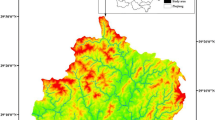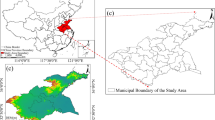Abstract
Effective information about ecosystem services is essential to help optimize and prioritize activities that support conservation planning in the face of land use and climate changes. This study shows an approach that integrates several dissimilar models for assessing water-related ecosystem services to predict values in 2050 under three land use scenarios in the Yanhe watershed. The simulated output variables pertaining to water yield and sediment yield were used as indicators for two ecosystem-regulating services, i.e., water flow regulation and erosion regulation, which were quantified using the soil and water assessment tool (SWAT) model. The model results were translated into a relative ecosystem service valuation scale, which facilitated the analysis of spatial and seasonal changes and served as the basis for the applied mapping approach. The simulated results indicate that higher water-related regulation services were concentrated in the middle and lower reaches of rivers with high water yield and low sediment erosion. The highest water flow regulation services occurred in summer; nevertheless, this was when erosion regulation services were the lowest compared to other periods in 2050. A comparison of the three land use scenarios showed differences in the water-related regulation services. Scenario 1, with high forest coverage, had the highest erosion regulation services, but the water flow regulation services were the lowest. Scenario 3 showed the reverse pattern. Scenario 2 had intermediate water flow regulation and erosion regulation. Increasing vegetation cover in the watershed is conducive to controlling water and soil erosion but could lead to a decline in available water resources. Spatial mapping is a powerful tool for displaying the spatiotemporal differences in the water-related regulation services delivered by ecosystems and can help decision makers optimize land use in the future, with the goal of maximizing the benefits offered by ecological services in the Yanhe watershed.








Similar content being viewed by others
References
Abbaspour KC, Rouholahnejad E, Vaghefi S, Srinivasan R, Yang H, Kløve B (2015) A continental-scale hydrology and water quality model for Europe: calibration and uncertainty of a high-resolution large-scale SWAT model. J Hydrol 524:733–752
Bellard C, Bertelsmeier C, Leadley P, Thuiller W, Courchamp F (2012) Impacts of climate change on the future of biodiversity. Ecol Lett 15:365–377
Burkhard B, Kroll F, Nedkov S, Müller F (2012) Mapping ecosystem service supply, demand and budgets. Ecol Indic 21:17–29
Burkhard B, Kandziora M, Hou Y, Müller F (2014) Ecosystem service potentials, flows and demands-concepts for spatial localisation, indication and quantification. Landsc Online 34:1–32
Chen J, Brissette FP, Poulin A, Leconte R (2011) Overall uncertainty study of the hydrological impacts of climate change for a Canadian watershed. Water Resour Res 47:W12509. https://doi.org/10.1029/2011WR010602
Fan M, Shibata H (2015) Simulation of watershed hydrology and stream water quality under land use and climate change scenarios in Teshio River watershed, northern Japan. Ecol Indic 50:79–89
Fu B, Wang S, Su C, Forsius M (2013) Linking ecosystem processes and ecosystem services. Curr Opin Environ Sustain 5:4–10
Hao R, Yu D, Liu Y, Liu Y, Qiao J, Wang X, Du J (2017) Impacts of changes in climate and landscape pattern on ecosystem services. Sci Total Environ 579:718–728
Her Y, Frankenberger J, Chaubey I, Srinivasan R (2015) Threshold effects in HRU definition of the soil and water assessment tool. Trans ASABE 58:367–378
Jacobs S, Burkhard B, Van Daele T, Staes J, Schneiders A (2015) The matrix reloaded’: a review of expert knowledge use for mapping ecosystem services. Ecol Model 295:21–30
Jiao Y, Lei H, Yang D, Huang M, Liu D, Yuan X (2017) Impact of vegetation dynamics on hydrological processes in a semi-arid basin by using a land surface-hydrology coupled model. J Hydrol 551:116–131
Karabulut A, Egoh BN, Lanzanova D, Grizzetti B, Bidoglio G, Pagliero L, Bouraoui F, Aloe A, Reynaud A, Maes J, Vandecasteele I, Mubareka S (2016) Mapping water provisioning services to support the ecosystem–water–food–energy nexus in the Danube river basin. Ecosyst Serv 17:278–292
Leta OT, Nossent J, Velez C, Shrestha NK, van Griensven A, Bauwens W (2015) Assessment of the different sources of uncertainty in a SWAT model of the River Senne (Belgium). Environ Model Softw 68:129–146
Li Z, Fang H (2016) Impacts of climate change on water erosion: a review. Earth Sci Rev 163:94–117
Li J, Zhou ZX (2015) Coupled analysis on landscape pattern and hydrological processes in Yanhe watershed of China. Sci Total Environ 505:927–938
Liao Y, Gao G, Xie Y (2009) Impacts of climate changes on parameters of a weather generator for daily precipitation in China. Acta Geograph Sin 64:871–878
Liao Y, Chen D, Xie Y (2013) Spatial variability of the parameters of the Chinese stochastic weather generator for daily non-precipitation variables simulation in China. Acta Meteorol Sin 71:1103–1114
Lin L, Sills E, Cheshire H (2014) Targeting areas for reducing emissions from deforestation and forest degradation (REDD+) projects in Tanzania. Glob Environ Chang 24:277–286
Lin B, Chen X, Yao H, Chen Y, Liu M, Gao L, James A (2015) Analyses of landuse change impacts on catchment runoff using different time indicators based on SWAT model. Ecol Indic 58:55–63
Luo Y, Yang ST, Zhao CS, Liu XY, Liu CM, Wu LN, Zhao HG, Zhang YC (2014) The effect of environmental factors on spatial variability in land use change in the high-sediment region of China’s loess plateau. J Geogr Sci 24:802–814
Meaurio M, Zabaleta A, Uriarte JA, Srinivasan R, Antigüedad I (2015) Evaluation of SWAT models performance to simulate streamflow spatial origin. The case of a small forested watershed. J Hydrol 525:326–334
Neitsch SL, Arnold JG, Kiniry JR, Williams JR (2011) Soil and water assessment tool theoretical documentation version 2009. Texas Water Resources Institute, College Station
Ning J, Gao Z, Lu Q (2015) Runoff simulation using a modified SWAT model with spatially continuous HRUs. Environ Earth Sci 74:5895–5905
Panagopoulos Y, Gassman PW, Arritt RW, Herzmann DE, Campbell TD, Jha MK, Kling CL, Srinivasan R, White M, Arnold JG (2014) Surface water quality and cropping systems sustainability under a changing climate in the Upper Mississippi River Basin. J Soil Water Conserv 69:483–494
Panagopoulos Y, Gassman PW, Jha MK, Kling CL, Campbell T, Srinivasan R, White M, Arnold JG (2015) A refined regional modeling approach for the Corn Belt—experiences and recommendations for large-scale integrated modeling. J Hydrol 524:348–366
Peng J, Liu Y, Liu Z, Yang Y (2017) Mapping spatial non-stationarity of human-natural factors associated with agricultural landscape multifunctionality in Beijing–Tianjin–Hebei region, China. Agric Ecosyst Environ 246:221–233
Pérez-Vega A, Mas J-F, Ligmann-Zielinska A (2012) Comparing two approaches to land use/cover change modeling and their implications for the assessment of biodiversity loss in a deciduous tropical forest. Environ Model Softw 29:11–23
Pervez MS, Henebry GM (2015) Assessing the impacts of climate and land use and land cover change on the freshwater availability in the Brahmaputra River basin. J Hydrol: Reg Stud 3:285–311
Pontius RG Jr, Schneider LC (2001) Land-cover change model validation by an ROC method for the Ipswich watershed, Massachusetts, USA. Agric Ecosyst Environ 85:239–248
Pullanikkatil D, Palamuleni LG, Ruhiiga TM (2016) Land use/land cover change and implications for ecosystems services in the Likangala River Catchment, Malawi. Phys Chem Earth Parts A/B/C 93:96–103
Qiu L-J, Zheng F-L, Yin R-S (2012) SWAT-based runoff and sediment simulation in a small watershed, the loessial hilly-gullied region of China: capabilities and challenges. Int J Sediment Res 27:226–234
Quintas-Soriano C, Castro AJ, Castro H, García-Llorente M (2016) Impacts of land use change on ecosystem services and implications for human well-being in Spanish drylands. Land Use Policy 54:534–548
Rasul G (2016) Managing the food, water, and energy nexus for achieving the Sustainable Development Goals in South Asia. Environ Dev 18:14–25
Schmalz B, Kruse M, Kiesel J, Müller F, Fohrer N (2016) Water-related ecosystem services in western Siberian lowland basins—analysing and mapping spatial and seasonal effects on regulating services based on ecohydrological modelling results. Ecol Indic 71:55–65
Shrestha MK, Recknagel F, Frizenschaf J, Meyer W (2017) Future climate and land uses effects on flow and nutrient loads of a Mediterranean catchment in South Australia. Sci Total Environ 590-591:186–193
Strauch M, Bernhofer C, Koide S, Volk M, Lorz C, Makeschin F (2012) Using precipitation data ensemble for uncertainty analysis in SWAT streamflow simulation. J Hydrol 414-415:413–424
Sun WY, Shao QQ, Liu JY, Zhai J (2014) Assessing the effects of land use and topography on soil erosion on the loess plateau in China. Catena 121:151–163
Tan ML, Ficklin DL, Dixon B, Ibrahim AL, Yusop Z, Chaplot V (2015) Impacts of DEM resolution, source, and resampling technique on SWAT-simulated streamflow. Appl Geogr 63:357–368
Uniyal B, Jha MK, Verma AK (2015) Assessing climate change impact on water balance components of a river basin using SWAT model. Water Resour Manag 29:4767–4785
Vigerstol KL, Aukema JE (2011) A comparison of tools for modeling freshwater ecosystem services. J Environ Manag 92:2403–2409
van Vliet J, Bregt AK, Brown DG, van Delden H, Heckbert S, Verburg PH (2016) A review of current calibration and validation practices in land-change modeling. Environ Model Softw 82:174–182
Wang S, Fu B, Piao S, Lü Y, Ciais P, Feng X, Wang Y (2015) Reduced sediment transport in the Yellow River due to anthropogenic changes. Nat Geosci 9:38–41
Williams JR, Arnold JG (1997) A system of erosion—sediment yield models. Soil Technol 11:43–55
Wilson CO, Weng Q (2011) Simulating the impacts of future land use and climate changes on surface water quality in the Des Plaines River watershed, Chicago Metropolitan Statistical Area, Illinois. Sci Total Environ 409:4387–4405
Woldemeskel FM, Sharma A, Sivakumar B, Mehrotra R (2012) An error estimation method for precipitation and temperature projections for future climates. J Geophys Res Atmos 117:1–13. https://doi.org/10.1029/2012jd018062
Wu C-F, Lin Y-P, Chiang L-C, Huang T (2014) Assessing highway's impacts on landscape patterns and ecosystem services: a case study in Puli Township, Taiwan. Landsc Urban Plan 128:60–71
Xu F, Dong G, Wang Q, Liu L, Yu W, Men C, Liu R (2016) Impacts of DEM uncertainties on critical source areas identification for non-point source pollution control based on SWAT model. J Hydrol 540:355–367
Yan R, Zhang X, Yan S, Zhang J, Chen H (2017) Spatial patterns of hydrological responses to land use/cover change in a catchment on the loess plateau, China. Ecol Indic. https://doi.org/10.1016/j.ecolind.2017.04.013
Yang X, Zheng X-Q, Chen R (2014) A land use change model: integrating landscape pattern indexes and Markov-CA. Ecol Model 283:1–7
Yesuf HM, Assen M, Alamirew T, Melesse AM (2015) Modeling of sediment yield in Maybar gauged watershed using SWAT, northeast Ethiopia. Catena 127:191–205
Zhang P, Liu R, Bao Y, Wang J, Yu W, Shen Z (2014a) Uncertainty of SWAT model at different DEM resolutions in a large mountainous watershed. Water Res 53:132–144
Zhang X, Y-P X, Fu G (2014b) Uncertainties in SWAT extreme flow simulation under climate change. J Hydrol 515:205–222
Zhang D, Chen X, Yao H, Lin B (2015) Improved calibration scheme of SWAT by separating wet and dry seasons. Ecol Model 301:54–61
Zhao G, Liu J, Kuang W, Ouyang Z, Xie Z (2015) Disturbance impacts of land use change on biodiversity conservation priority areas across China: 1990–2010. J Geogr Sci 25:515–529
Zhou ZX, Li J (2015) The correlation analysis on the landscape pattern index and hydrological processes in the Yanhe watershed, China. J Hydrol 524:417–426
Zuo D, Xu Z, Yao W, Jin S, Xiao P, Ran D (2016) Assessing the effects of changes in land use and climate on runoff and sediment yields from a watershed in the loess plateau of China. Sci Total Environ 544:238–250
Funding
This work was jointly supported by the National Natural Science Foundation of China (grant number 41771198), and the National Natural Science Foundation of China (grant number 41771576).
Author information
Authors and Affiliations
Corresponding author
Additional information
Responsible editor: Marcus Schulz
Electronic supplementary material
ESM 1
(PDF 82 kb).
Rights and permissions
About this article
Cite this article
Chen, D., Li, J., Zhou, Z. et al. Simulating and mapping the spatial and seasonal effects of future climate and land -use changes on ecosystem services in the Yanhe watershed, China. Environ Sci Pollut Res 25, 1115–1131 (2018). https://doi.org/10.1007/s11356-017-0499-8
Received:
Accepted:
Published:
Issue Date:
DOI: https://doi.org/10.1007/s11356-017-0499-8




